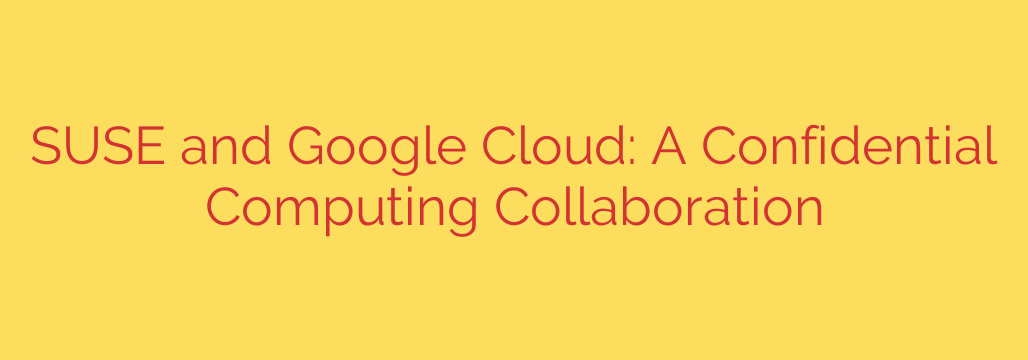
The Next Frontier in Cloud Security: Why Encrypting Data-in-Use is a Game-Changer
For years, the gold standard for data security has focused on two primary states: data-at-rest (encrypting files on a hard drive) and data-in-transit (securing data as it moves across a network). But what about the third state—data-in-use? This has long been the missing piece of the security puzzle. When data is being actively processed in your server’s memory (RAM), it has traditionally been vulnerable.
Today, that vulnerability is being eliminated by a revolutionary technology: Confidential Computing. This approach secures your most sensitive information even while it is being actively processed, creating a truly end-to-end encryption strategy that transforms cloud security.
What Exactly is Confidential Computing?
Confidential Computing protects data inside a hardware-based Trusted Execution Environment (TEE). Think of a TEE as a secure, isolated black box for your applications and data.
While your virtual machine is running, its memory is completely encrypted. The encryption keys are generated and managed by the processor itself, making them inaccessible to anyone else—not even the cloud provider, the system administrators, or other applications running on the same physical server. This ensures that the contents of your application’s memory remain completely private and shielded from unauthorized observation or modification.
A Breakthrough for Processing Sensitive Data in the Cloud
The implications of this technology are massive, especially for industries bound by strict regulatory and privacy requirements. Here’s why it’s such a significant leap forward:
- It closes the final security gap. By encrypting data-in-use, confidential computing completes the data protection triad. Your information is now protected whether it’s stored, moving, or being actively used.
- It enables migration of the most sensitive workloads. Organizations in finance, healthcare, government, and research have often hesitated to move their most critical applications to the public cloud. Confidential computing removes this barrier, allowing them to leverage the cloud’s scalability and efficiency without compromising on data privacy.
- It dramatically reduces the attack surface. Even if an attacker were to gain privileged access to the cloud infrastructure or the server’s hypervisor, the data and code running inside the confidential virtual machine would remain an unreadable, encrypted block.
- It strengthens regulatory compliance. For regulations like GDPR, CCPA, and HIPAA, proving that sensitive personal data is protected at all times is paramount. Confidential computing provides a powerful, verifiable mechanism to meet these stringent requirements.
How Does It Work Under the Hood?
This level of security isn’t just software—it’s built on a foundation of cutting-edge hardware and a collaborative software ecosystem.
The technology is powered by specialized features in modern server CPUs, such as AMD’s Secure Encrypted Virtualization (SEV). When a confidential virtual machine is launched, the processor automatically encrypts all data moving into or out of the system’s memory.
Leading cloud providers now offer Confidential VMs that leverage this hardware capability. To make this accessible, enterprise-grade operating systems have been specifically hardened and optimized to run seamlessly in these secure environments. This close integration between the hardware, cloud platform, and operating system is what makes the technology both powerful and practical.
Critically, this entire process is designed to be transparent to your applications. In most cases, you can “lift and shift” existing workloads into a confidential computing environment without rewriting a single line of code.
Actionable Security Tips for Adopting Confidential Computing
Ready to leverage this next-generation security for your own operations? Here are a few practical steps to get started:
- Identify Your Most Critical Workloads. Start by auditing your applications. Pinpoint those that handle personally identifiable information (PII), financial records, proprietary algorithms, or valuable intellectual property. These are the prime candidates for migration to a confidential environment.
- Choose a Compatible Cloud and OS. Work with a major cloud provider that offers confidential VMs as a standard service. Ensure you are using a trusted, enterprise-grade Linux distribution that is fully supported and optimized for these secure virtual machines.
- Prioritize End-to-End Encryption. Make confidential computing a core part of your security strategy. Educate your teams on the importance of protecting data in all three states: at rest, in transit, and now, in use.
- Verify Your Environment. Take advantage of attestation services. These services cryptographically verify that your workload is running inside a genuine TEE, providing an auditable report that proves your data is secure and isolated.
The era of leaving data exposed during processing is over. Confidential computing is no longer a futuristic concept—it is a practical and essential security control for any organization serious about protecting its most valuable digital assets in the cloud.
Source: https://cloud.google.com/blog/products/identity-security/how-suse-and-google-cloud-collaborate-on-confidential-computing/








